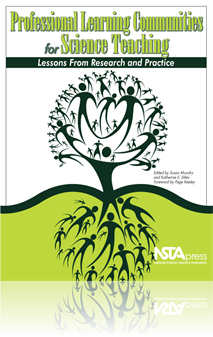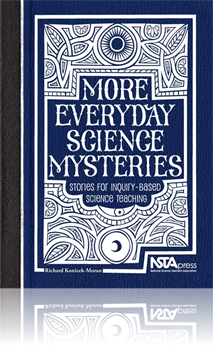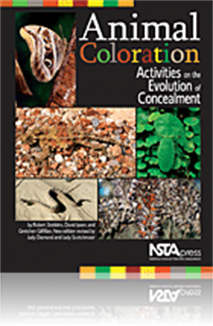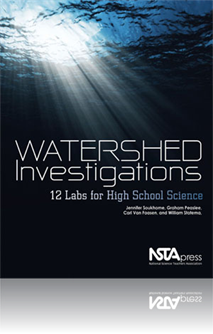All Book Chapters
Book Chapter
Whether or not a boat floats is determined by its shape and density. In this activity, students discover how and why boats float by designing different hull shapes and finding which design holds the most weight. Students record, calculate, and interp...
Book Chapter
Determining the Size and Shape of the Blind Spot
What exactly is the blind spot? It is the place where the optic nerve meets the back of the retina. Because no sensory cells are present in the retina at the meeting point, a “hole” is created in the field of view of each eye. The brain “fills ...
Book Chapter
Daniel and the Old Lion Hunter
Daniel Bernoulli wanted to be the Newton of the eighteenth century; he thought he could do it by studying fluids (by that he meant liquid and gases). His thoughts and his principle will percolate in other heads and help bring changes in science and l...
Book Chapter
The Promise of Professional Learning Communities
In this chapter, the authors discuss the origin and the characteristics of professional learning communities (PLCs) and summarize the research findings on the impact and results achieved by schools that are organized as PLCs. ...
Book Chapter
"Late-Start Mondays": The Catalyst for Change in an Urban High School
At the high school level, the task of creating a whole-school community of practice is often monumental and requires tremendous energy to disrupt the status quo. The story that follows describes the process by which a large, urban high school formed ...
Book Chapter
Teaching Learning Collaborative: A Process for Supporting Professional Learning Communities
The teaching learning collaborative (TLC) is a unique professional development strategy that engages groups of teachers in collaborative planning and teaching of a science lesson, coaching and mentoring, and examining student work. In this chapter, t...
Book Chapter
Building Professional Development Cadres
This chapter begins with a vignette based on several anecdotes that were relayed to the authors during their years working in the Los Angeles basin with a cadre of professional developers. This story sets the stage for exploring challenges tackled by...
Book Chapter
Creating and Sustaining Science-Focused Professional Learning Communities Through Partnerships
In this chapter, the authors share selected components of The North Cascades and Olympic Science Partnership (NCOSP) model for professional learning communities (PLCs) and the impact those communities had on instruction and student learning. They off...
Book Chapter
After five years of developing and investigating professional learning communities (PLCs) in school districts in Arizona, the authors have uncovered attributes that differentiate high-performing PLCs from lower-performing PLCs and have begun to uncov...
Book Chapter
The Role of Local and State Science Leaders in Developing Professional Learning Communities
This chapter tells two stories, both focused on the role of science leadership in developing the teacher leadership that is essential for creating and maintaining professional learning communities (PLCs). The first story provides insight into how dis...
Book Chapter
The K20 Model develops professional learning communities (PLCs) and has been successful in district-wide and school initiatives across Oklahoma. It is based on four interrelated structures for engaging people in communities: networks, PLCS, communiti...
Book Chapter
This book, and particularly the stories which lie within, provide an opportunity for students to take ownership of their learning and learn science in a way that will give them a more positive attitude about science. In addition, it will serve to hel...
Book Chapter
Segmented worms are considered “yucky” by a great many people, yet they are members of a large animal group that populates the entire world and provides a great service to our planet. This story should stimulate students to want to know more abou...
Book Chapter
This story is true, although Maria and Enrique are fictional characters. A barred owl does live in the rafter of the chickee at Shark Valley and does drop owl pellets from its nest almost daily. The purpose of this story is twofold: (1) to learn more...
Book Chapter
Trees From Helicopters, Continued
Maples are very interesting trees with lots of variation in form. They provide a view of diversity in plants as well as a chance to look at natural phenomena that is very common to anyone who has had a maple tree near them. The main purpose of this s...
Book Chapter
Flowers: More Than Just Pretty
Children love to look at flowers but few are inclined to become familiar with the structure and function of the flower. This story is aimed at providing some motivation for children to learn about one of the most important evolutionary developments i...
Book Chapter
Hardly a day goes by without something arriving by e-mail or being posted on the internet that just doesn’t sound true. The students in this story are depicted as having alert skepticism about things that don’t actually add up in their minds and ...
Book Chapter
Magnetism is a force that acts over a distance. Children play with magnetic toys all of the time. Any family that has a refrigerator knows that the number of magnets on the door defines the size of the appliance. This story should give students an op...
Book Chapter
This story should give students an opportunity to discover that every liquid has its own unique boiling point and that heat applied to any liquid that has reached its boiling point will not result in an increase in temperature but will be used to cha...
Book Chapter
Dissolving things in the universal solvent water is an everyday experience for almost all of us. We don’t have a lot of trouble dissolving honey in hot tea, but when it comes to sweetening cold iced tea, it is almost impossible. Obviously, water is...
Book Chapter
This story poses a challenge to solve the mystery of light, color, and how we see color. It also asks the question, “What is color?” After investigating the phenomena of color and color filters, students should realize that light is made up of ma...
Book Chapter
This story is designed to motivate students to explore how mirrors work and how mirrors reflect the light—first reflected from objects to the mirror and then to our eyes as images—and to discover in this particular case the famed rule that “the...
Book Chapter
Using the Book and the Stories
It is often difficult for overburdened teachers to develop lessons or activities that are compatible with the everyday life experiences of their students. A major premise of this book is that if students can see the real-life implications of science ...
Book Chapter
Using the Book in Different Ways
Although the book was originally designed for use with K–8 students by teachers or adults in informal settings, it became obvious that a book containing stories and content material for teachers who are intent on teaching in an inquiry mode had oth...
Book Chapter
The Link Between Science, Inquiry, and Language Literacy
There is currently a strong effort to combine science and literacy, because a growing body of research stresses the importance of language in learning science. Discussion, argumentation, discourse of all kinds, group consensus, and social interaction...
Book Chapter
What’s Hiding in the Woodpile?
Wood comes from trees, right? It is full of potential chemical energy that can produce heat when it is put into a stove or fireplace and burned. Yet, in this story, the Earth’s bounty seems to produce a cooler room. What can be the cause? Thermodyn...
Book Chapter
This story is based upon using solar energy and a variety of materials to modify and channel this energy to capture and hold heat. Almost everybody has experienced the differences in temperature due to sunshine passing through windows into an enclose...
Book Chapter
In 1991 and 1992, John Leach, Bonnie Shapiro, and the author did a study in which they interviewed approximately 400 students from the United Kingdom, Canada, and the United States about their beliefs surrounding the decay of an apple over a year’s...
Book Chapter
This story obviously is aimed at the technology standards. Two simple timing devices are mentioned with the suggestion that more are possible. These can be improved to meet the challenge or other devices could be invented. Students are being challeng...
Book Chapter
The two concepts at work here are conservation of matter and the question about many surfaces vs. fewer surfaces absorbing heat. You may wonder what this story is doing in the Earth system science area, but it has to do not only with thermodynamics a...
Book Chapter
Most animals are patterned. While some markings may serve as an advertisement, many appear to function in concealment. Because of the principal way in which they seem to function, such markings are often termed disruptive coloration. Although there a...
Book Chapter
Modeling Glacial Features With Sand
In this investigation, students make a model of the different erosional features of valley and continental glaciers out of sand and determine their impact on topography and hydrology. ...
Book Chapter
Aquatic Macroinvertebrate Identification
Everyone is familiar with terrestrial insects such as dragonflies, houseflies, mosquitoes, and beetles, but many of us are unaware that several insects live in the water during their larval stages. These insects are part of a larger group of organism...
Book Chapter
Factors That Affect Eutrophication
In this investigation, the effects of excess nutrients (nitrate and phosphate) on algae will be examined. An excess of these nutrients can lead to eutrophication in ponds and lakes. Eutrophic lakes typically are shallow, have mucky bottoms, and have ...
Book Chapter
This investigation consists of two parts, in which students first model the effects of groundwater contamination and then track the flow of the contamination. However, Part I does not have to be done in order to do Part II. This Teacher Information s...
Book Chapter
Glacial Features of a Watershed
The objective of this investigation is for students to learn how glaciers shaped a watershed. ...
Book Chapter
This investigation gives students the opportunity to view the outside world and bring science into the field. Teaching students how to identify plants gives them a greater appreciation for nature, just as learning to read words lets young students be...
Book Chapter
Learning how to delineate a wetland using official criteria can be an enlightening experience for students and teachers. The objective of this investigation is for students to delineate the boundaries of an area in a watershed and categorize it as a ...
Book Chapter
In this investigation, students will select, identify, and test a common plant for allelopathy by extracting the plant’s natural chemicals and measuring the effect on the germination of lettuce seeds. They will analyze the data statistically to det...
Book Chapter
When humans change the natural topography, certain effects are likely to be seen in a watershed. The transportation of water and sediment increases when streams are straightened and, with the increased flow rate of water, erosion also increases. All ...



.jpg)
.jpg)




